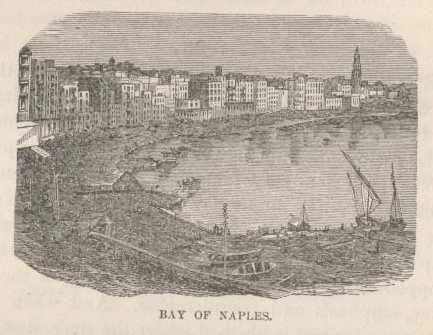“See Naples and die.” Well, I do not know that one would necessarily die after merely seeing it, but to attempt to live there might turn out a little differently. To see Naples as we saw it in the early dawn from far up on the side of Vesuvius, is to see a picture of wonderful beauty. At that distance its dingy buildings looked white--and so, rank on rank of balconies, windows and roofs, they piled themselves up from the blue ocean till the colossal castle of St. Elmo topped the grand white pyramid and gave the picture symmetry, emphasis and completeness. And when its lilies turned to roses--when it blushed under the sun’s first kiss--it was beautiful beyond all description. One might well say, then, “See Naples and die.” The frame of the picture was charming, itself. In front, the smooth sea--a vast mosaic of many colors; the lofty islands swimming in a dreamy haze in the distance; at our end of the city the stately double peak of Vesuvius, and its strong black ribs and seams of lava stretching down to the limitless level campagna--a green carpet that enchants the eye and leads it on and on, past clusters of trees, and isolated houses, and snowy villages, until it shreds out in a fringe of mist and general vagueness far away. It is from the Hermitage, there on the side of Vesuvius, that one should “see Naples and die.”
But do not go within the walls and look at it in detail. That takes away some of the romance of the thing. The people are filthy in their habits, and this makes filthy streets and breeds disagreeable sights and smells. There never was a community so prejudiced against the cholera as these Neapolitans are. But they have good reason to be. The cholera generally vanquishes a Neapolitan when it seizes him, because, you understand, before the doctor can dig through the dirt and get at the disease the man dies. The upper classes take a sea-bath every day, and are pretty decent.